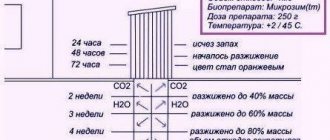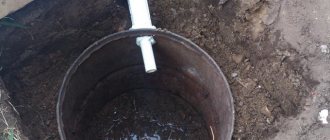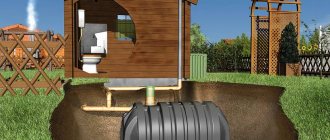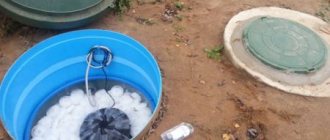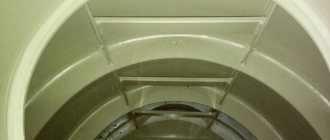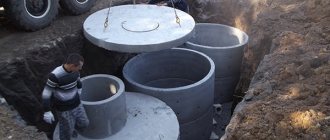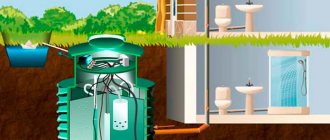The sewerage system is one of the essential elements of life support. If owners of apartments and houses in cottage villages easily solve this issue by connecting to a central sewer system, then summer residents must equip the system on their own. Tire sewerage is perhaps the simplest and most affordable option for arranging the system. We’ll look at how to properly make a sewer system out of tires with your own hands in order to create a smoothly functioning system that will last for more than one season.
Septic tank or cesspool ↑
Owners of country houses intended for seasonal living solve the issue of sewerage and wastewater disposal in different ways. Some dig cesspools, others buy ready-made factory-made plastic septic tanks, and others set up a system using improvised means:
- bricks;
- iron barrels;
- concrete rings;
- car tires.
The cesspool is a “well” buried 2-2.5 meters deep.
The bottom of the “well” is lined with crushed stone, which performs a filtration function, and the walls prevent runoff from entering the upper soil layers.
Some people mistakenly believe that a septic tank is analogous to a cesspool. In fact, it is a more modern and modernized type of sewer that provides much greater efficiency. A cesspool consists of one tank where wastewater accumulates, and a septic tank consists of two or three containers located one after another.
A septic tank consists of several interconnected tanks
The wastewater coming through the sewer pipes coming from the house first enters the first “storage” tank, the main function of which is to carry out primary purification and processing by bacteria. The wastewater, cleared of large particles, enters a second tank of slightly smaller volume, where it is also purified by bacteria. As a result of such processing, up to 90% of the volume of liquid entering the septic tank at the exit is in the form of purified water.
Which wells are included in the system
When providing drainage with your own hands, the following types of drainage wells are provided:
- Rotary option
. Such wells are installed with an extended pipeline at the following points: through one turn of the pipe and in the place where several pipes converge into one line. The problem to be solved is cleaning the pipes (drains), since dirt plugs often occur in bend areas. - Absorption type
. These structures do not require prefabricated or main elements. They are dug at different points where water accumulates, which itself flows into wells. When installing such structures, it is important to form a surface slope so that moisture flows into them on its own. - Water intake wells
. At their core, these are sealed containers into which all collected moisture flows through drains. As they fill, water is pumped out or used for technical needs, for example, for irrigation. - Filter structures
are the final element of the drainage system, located in a remote area where water can be discharged into the ground. In principle, this is a variant of a water intake well, in which the bottom is not sealed, but is made in the form of a natural filter. Water seeps into the ground through the bottom zone.
The design of drainage wells depends on the task being performed, with this difference mainly due to the structure of the bottom area. The bottom can be arranged in two ways: be sealed in the form of concrete pouring or non-sealed, based on a cushion of sand and crushed stone. The well shaft has a depth sufficient to accumulate the required volume of water.
Most often, it is 3-5 m. The shaft wall must have waterproofing to prevent the collected moisture from seeping into the upper layers of the soil.
Finally, the top plate and hatch complete the structure. In production wells, a ladder is installed inside the shaft.
Sewerage from tires: pros and cons ↑
Among the undeniable advantages of arranging a septic tank from car tires, it is worth highlighting:
- Availability of material. It won’t be difficult to get tires by saving them yourself or asking at the nearest tire shop.
- Low cost. The installation of a sewer well does not require any investment or hiring of hired workers.
- Easy to install. If the construction of a factory septic tank cannot be done without the use of small-scale mechanization, then the construction of a well from car tires stacked on top of each other can be easily done by yourself without anyone’s help.
For work, you can use old tires from any equipment
But despite all the advantages, tire sewerage is not without its disadvantages. These include:
- Small capacity. Such a sewerage structure is effective only for arranging dachas and houses where no more than three family members live. But in any case, the contents will have to be pumped out at least once a season.
- Seasonality of use. In the cold season at sub-zero temperatures, when the walls of the septic tank lined with rubber tires freeze, using the sewer system becomes difficult.
- The need for preventive examination. To extend the service life of the structure, once a year at the beginning of the season it is necessary to inspect the connections between the tires. If leaks are detected, all joints must be sealed using special compounds.
- Limited service life. Even with careful care and timely implementation of preventive measures, the service life of tire sewers does not exceed 20 years.
Both the septic tank and the cesspool must be cleaned as accumulation occurs, using sewer trucks.
A significant disadvantage of a well assembled from tires, if we are talking about its leaky version, is the sanitary “unreliability” of the structure. In addition, if you do not think through the issue of ventilation when installing a sewer system, there is a high probability of unpleasant odors appearing.
What is important to understand before starting work?
Purpose of the septic tank
A comfortable residential building will differ from all others in that it is equipped with the benefits of civilization. These are resources that are necessary for people to live in a home - gas, electricity, sewerage, water supply. If electricity, water supply and gas, or rather the problems associated with them, home owners somehow try to solve on their own and this even works out well, then installing sewerage is extremely expensive and will depend on whether there is a main pipe nearby so that you can it was necessary to drain wastewater from the residence.
The difference between a septic tank and a cesspool
A drainage pit and a septic tank are not equivalent concepts. These are completely different objects with different target directions. The cesspool is sealed and serves only to be filled with waste liquid. When it is full, the operation of the structure ceases. In order to continue to use it, you need to call a special sewage disposal machine that will pump out all the contents of the pit. And how different is a septic tank from it? Such a structure is not airtight.
Please note that waste water that enters a tank with loose walls begins to partially leak through them, and a large volume of water is absorbed into the bottom of the object.
When the container is only slightly filled, owners do not even need to think about how to pump out the contents. More intensive use of water resources, regular washing, filling the pool and visiting a bathhouse or sauna in the house will lead to the fact that the septic tank will quickly begin to overflow. The water in it will need to be pumped out, and for this you will need to call a sewer machine. But such a process will need to be performed extremely rarely, unlike the case when you had a cesspool.
Septic tanks vary in design features. The walls can be laid out from cinder block, brick, rubble stone, granite with holes for intensive moisture absorption. The bottom should be covered with crushed stone, expanded clay, broken brick, the soil should be left uncompacted. The personal material for building a septic tank on the territory of a summer cottage, cottage yard, or your own home is car tires.
Operating principle of the device
Creating your own septic tank for your home from autonomous tires instead of sewerage is interesting and even useful. Moreover, this is even more interesting in the case when the owner of private property wants to implement his plan using the cheapest building material - worn-out car tires. If you have your own car, then you can collect tires within one day around car workshops, as well as behind garage cooperatives.
Please note that such a waste water drainage network for a home is made using a minimum number of construction tools, materials and equipment.
You may not even particularly plan financial expenses. You just need to take into account one point: such a structure will not be designed for large volumes of liquid circulation. When draining water into a septic tank made from car tires, you should constantly monitor its level. A homemade, self-made septic tank made from waste rubber is considered an autonomous sewer system that performs biological treatment of wastewater. There is a container in the ground that is made from the inner cavities of car tires. A sewer pipe should be laid from the house, the installation of which will be carried out at an angle. The slope of the pipe should be such that the waste liquid flows into the container on its own.
Sewage in the form of large contaminated particles will simply settle to the bottom surface. Next, the activity of bacteria begins, which will purify the wastewater. Partially purified water will begin to seep through the cracks and porous bottom between the tires into the earthen walls of the septic tank. More intensive cleaning will require the use of chemicals. They will decompose silt deposits and also dilute them to the maximum.
Requirements for the location of the septic tank ↑
Before making a sewer system from tires for water, you need to carefully consider the location of the cesspool or septic tank. In addition, it is necessary to calculate the volume of the tank so that the structure does not cause harmful compounds to enter the soil.
According to sanitary standards, the volume of a cesspool is calculated based on the fact that it must be at least three days' water consumption. For year-round homes, this figure per person per day averages about 200 liters, for dachas - up to 50 liters.
The layout of the cesspool or septic tank should take into account the required distances to significant objects on the sites
Advice: a storage-type sewer well should be placed in such a way as to provide free access to it for a sewer truck.
When planning to build a sewer system for a private house from tires, it is worth considering two limiting factors:
- Close location of groundwater (less than 5 meters). This indicator excludes the construction of pits without a bottom. With heavy rainfall and rising groundwater levels, the reservoir will fill spontaneously.
- Clay soil. Soil with low water permeability significantly reduces the speed and quality of filtration. For this reason, it will be quite problematic to ensure timely removal of the contents of the tank in a natural way.
The weak tightness of the tire well walls forces the structure to be located further from residential premises and water intake sources than other sewer installations built from other moisture-resistant materials.
Why are drainage wells needed?
At its core, drainage is a set of hydraulic engineering measures to protect structures and land from the effects of excess moisture formed due to precipitation, floods, seasonal increases in groundwater levels, etc. Any, even the most durable structures begin to gradually collapse if unplanned water undermines the foundation. Fertile lands that are flooded with water for a long time will simply lose all their best qualities.
These circumstances lead to the need to protect buildings and your site from dangerous influences, especially in areas with high natural humidity. For this purpose, a special drainage system is manufactured that solves specific problems: collection, drainage, removal and disposal of excess water mass
. Such systems are created with your own hands, but taking into account the recommendations of specialists.
Structurally, drainage complexes include the following components:
- Water intake elements.
They are placed directly in the flood zone and can be formed in the form of trenches, to which pipe drains are connected. - Main elements
: pipeline (drains) or trench system for draining water. - Recycling elements
. This part completes the process, that is, it performs the final operation: storing water or discharging it into the soil in a safe place. - Additional operational elements
. These include control and shut-off devices, devices and structures for operating and repairing the system.
It is considered an important part of the entire drainage system. It can perform recycling functions (the main task) or play the role of an additional operational element. The operation and efficiency of the entire system depend on the reliability and correctness of its installation. In particular, its volume must allow the collection of all drained water, otherwise the drainage simply will not provide the required drainage.
Technology for arranging a cesspool ↑
Preparation of materials ↑
A car tire, which is an elastic and fairly durable rubber-fabric shell with metal threads, is an excellent basis for arranging a cesspool or walls.
To build a sewer well, you can use any modifications of tires:
- small passenger car tires measuring 15 inches and above;
- tires for trucks with a diameter of 1 meter or more.
Advice: craftsmen who have already built their own sewer wells recommend using low-profile tires for this purpose, the ratio of the profile height to the width of the product is 80 units.
Service station employees will be happy to give them away free of charge. After all, in this way they solve for themselves the problem of recycling waste material, which has a hazard class of IV. The number of tires depends on the size of the structure being built.
For a medium-sized cesspool, 8-10 pieces are enough
To construct a sewer “well” and carry out the work, you will also need materials and a set of tools:
- Drainage pipe 1.5-1.8 m long.
- Ventilation pipe connection.
- Crushed stone or gravel.
- Jigsaw.
- Bayonet and shovel.
- Garden drill.
- Sealant.
- Roulette.
The ventilation pipe can be made from a PVC pipe D 10 cm. To arrange drainage, you need to use a section of pipe 80-100 mm, in the walls of which holes are made along the entire length of the product. Polypropylene pipes are best suited for this purpose; holes can be easily made in their strong but soft walls.
Digging a pit ↑
Having outlined the location of the future “well”, they begin to dig a pit. To simplify your task and avoid removing excess soil, first dig a shaft the size of which corresponds to the diameter of the outer section of the selected tires, and then move to the center.
Digging a pit is the most difficult stage of work, which can take several days to complete.
If you wish, you can make your work easier and speed up the process by using small-scale mechanization tools or hiring assistants for excavation work.
Important! The depth of the pit should not exceed 2-2.5 meters. If the pit is placed deeper, problems with pumping out wastewater may arise.
Drainage arrangement ↑
Having reached the specified depth, the bottom of the pit is cleaned and leveled, and then a drainage system is installed. To do this, drill a hole in the center of the bottom using a garden drill, through which the drainage will go into the ground.
A section of a pre-prepared drainage pipe is inserted into the dug well, not forgetting to make several holes in it to speed up the outflow of water. The pipe is installed so that its upper edge rises 90-100 mm above the bottom surface.
Tip: to prevent the pipe from clogging with large waste particles, it is better to put a plastic mesh on its upper edge, which will act as a filter.
The bottom of the pit is lined with a layer of gravel or crushed stone 25-30 cm thick
For better filtration, the voids between the crushed stone can be filled with river sand.
Construction of the structure ↑
The first tire is laid on the leveled and compacted bottom of the pit. Having leveled its position horizontally, place a second tire on top.
Tip: To prevent solid waste water from accumulating inside the tires, you can cut off the rims that protrude from the inner surface. The easiest way to do this is with a jigsaw or a hacksaw.
After laying a stack of tires, you should get a vertical structure, the upper edge of which protrudes 5-10 cm above the ground surface
Scheme for arranging a sewer well made of tires
A trench is dug next to the excavated pit, into which a sewer pipeline will be laid, supplying wastewater from the house. The angle of inclination of the trench should be such that wastewater flows into the “well” by gravity.
The edge of the sewer pipe is inserted into a hole cut at a depth of 1 meter from the ground level in the wall of the “well”.
To strengthen the structure and prevent the tires from moving, the voids between the outer side of the tires and the walls of the pit are filled with soil. To seal the voids, you can use the remaining unused pieces of cut rubber.
Tip: to increase the strength of the structure and prevent the penetration of runoff into the soil, the edges of the tires can be connected with mounting “clamps”, and all joints between the tires can be filled with a sealing compound.
Laying ventilation ↑
Intensive decomposition of wastewater in a cesspool is possible only if there is access to atmospheric oxygen. To arrange ventilation, the pipe is attached to the wall of the structure and brought out from under the ceiling of the pit to a height of 1-2 meters above the level of the adjacent soil. The pipe inlet must be located no lower than the sewage filling level. This will avoid the accumulation of harmful gases and, as a result, the appearance of unpleasant odors.
The air will move due to the pressure difference in the storage tank and the atmosphere
Advice: to reduce the spread of stench in the area to “no”, install forced ventilation by attaching an exhaust motor to the upper end of the pipe.
All junctions between the walls of the cesspool and the inlet pipe must be carefully sealed.
A cover is installed on the top of the sewer “well”. It can be purchased in specialized stores or made from scrap materials that are highly resistant to moisture and temperature changes.
Ventilation arrangement
A tire septic tank with many chambers requires a through ventilation system. The ventilation pipe must pass through all the chambers, so holes should be provided for it in the walls - just like for overflow pipes.
A ventilation riser should be placed in each chamber - a pipe with a diameter of 10 cm at a height of 70 cm above the ground. The bottom edge of the ventilation opening must be at least 20 cm from the surface of the wastewater.
If it is not possible to make holes in the partitions of the sections above the level reached by the drains, then there is another option - ventilation through an overflow pipe. This option is feasible provided that the overflow pipe is laid above the wastewater level.
Construction of a septic tank with your own hands ↑
The technology for constructing a simple treatment plant from tires is not much different from the procedure described above.
The construction of a septic tank from tires is carried out in several stages:
- Dig a pit 2-2.5 m deep.
- The bottom of the pit is covered with a crushed stone “cushion” 30-40 cm thick.
- They build a “well” by placing 8-10 tires of the same diameter on top of each other.
- The inner rims of the laid out tires are cut off with a jigsaw.
- A concrete pipe with a diameter 2 times smaller than the size of the “well” is installed inside the shaft, the upper end of which is equipped with a filter mesh.
- Fill the voids between the outer side of the tires and the inner walls of the pit with soil, compacting the soil as much as possible.
- Install a pipe for ventilation.
- The upper rail of the structure is covered with a protective cover.
The length of the concrete pipe should be such that when installed in a vertical position, the upper end is located 10-15 cm below the edge of the last tire. This is necessary so that the pipe “takes” wastewater not from the surface, but from the thickness of the settled water.
Video: three-chamber septic tank made from truck tires ↑
The top of the septic tank can be decorated by building an impromptu flower garden from moisture-loving plants, the roots of which will absorb excess water. Variegated flowers will distract attention from the lid of an unattractive structure, and the wide foliage of decorative leafy plants will hide the sides of the structure protruding above the surface.
Recommendations from experienced owners ↑
And finally, a few simple tips that will help prevent difficulties and troubles when operating a self-made sewer system:
- It is better to construct a tire sewer in a private house on the leeward side of the house. This will protect the residents of the house from unpleasant odors emitted by the contents of the cesspool.
- When digging a pit, periodically check the diameter so that it does not narrow as you go deeper. When carrying out excavation work, use two types of shovels: bayonet - loosen the ground, shovel - remove the soil.
- It is advisable to equip the septic tank lid with a viewing window, through which it will be convenient to monitor the fill level of the tank.
- You can’t do without cleaning the “well”. But it is quite possible to reduce the number of these events. To do this, we recommend using autonomous sewer cleaning products.
Products containing bacteria are available in the form of powders and liquids
Microorganisms entering the collection will process organic waste. Some bacteria can even recycle toilet paper, decompose nitrate compounds and harmful chemicals. The volume of solid waste after such processing is only 20%.
Rules for building a structure
Do-it-yourself sewerage from tires is an excellent solution for those who do not want to spend a lot of money on building a septic tank, but want to get an effective design that will last a long time.
In order for the system to work as it should, certain rules must be followed during construction. This will guarantee not only the successful functioning of the tire sewer system, but will also reduce the risk of environmental problems that may arise as a result of ignoring the basic requirements for arranging a septic tank.
It is important to follow the following basic rules:
- You can start building a septic tank from wheels provided that the groundwater flows at a level below the 2-meter mark. This will ensure reliable fixation of the structure, which will eliminate shifts, erosion or deformation due to soil heaving.
- It is preferable to make sewerage in an area with sandy loam soil. This ensures optimal and rapid drainage of purified water.
- When constructing a sewer system, it is necessary to take into account how deep the ground freezes. It is important to follow this rule even when building a small tank into which household waste will fall.
- It is also worth considering that the sewage system from wheels must be correctly positioned relative to other buildings and sources of drinking water located on a private plot. So, the optimal distance between the house and the septic tank is 5 meters. Regarding water sources, it is necessary to locate the sewage system further from them by 20 or more meters. To minimize the risk of waste entering groundwater, it is recommended to locate a tire septic tank at the lowest point of the land plot.
- The water intake level is necessarily lower than the level of the treatment plant.
- It is imperative to ensure unimpeded passage for sewage treatment vehicles.
Advantages:
- no large financial costs;
- short sewer construction period;
- you can build it yourself without involving many people;
- any tires will do, regardless of newness and size;
- simple design.
Flaws:
- low productivity;
- lasts an average of 10-15 years;
- unpleasant odor;
- Incomplete tire sealing increases the risk of soil contamination with sewage.
Also, such sewerage is not suitable for areas with high soil moisture. It is also worth considering that if waste gets into surface or underground waters, the risk of a person developing dangerous infectious diseases will increase.
Where to start construction
It is important to obtain permission to build a sewer network if the depth of the pit exceeds 5 meters. It is not difficult to obtain it, especially if you comply with all the conditions for land surveying. These conditions are described in detail in the Land Code of the Russian Federation. If you have a cadastral passport received before 2014, they should be redone. The cost of surveying itself varies within 6,000 rubles.
Watch the video
If a communication cable passes through the site, it is necessary to obtain special permission from its owner. A specialist must arrive at the site and use a metal detector to establish a point where digging is prohibited.
The optimal place to place a pit
After receiving permission from all authorities, it is necessary to select a location for the sewer system. There are certain standards established by Sanpin that you need to follow. So, if the location of the sump is close to the place from which drinking water is obtained, the risk of sewage entering groundwater increases.
Due to leakage, drinking water becomes unfit for consumption. A sealed septic tank and a special filtration system will help avoid soil contamination.
Also, you should not build a sewer system close to a house or bathhouse, since otherwise, during the construction of the pit, the soil may settle, resulting in damage to the concrete base of the septic tank. In addition, if clogged, it can become wet, which will lead to a decrease in its strength over time.
Locating the tank too far from the house is also a bad option. This will significantly increase the cash costs of building the structure.
As a rule, at least one manhole is required for the external part of the sewer. If the pipeline is longer than 25 meters, additional wells will have to be added.
If the water supply is too long, there is a high probability that blockages will often form inside. This should be taken into account even though a special pump will be installed that will remove wastewater from the sewer.
